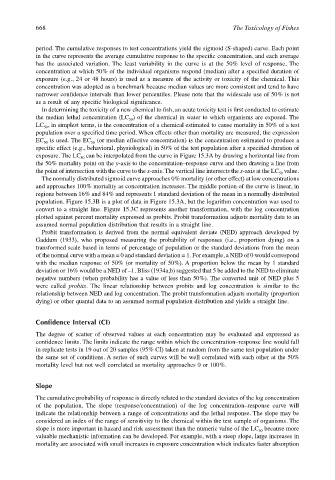Page 688 - The Toxicology of Fishes
P. 688
668 The Toxicology of Fishes
period. The cumulative responses to test concentrations yield the sigmoid (S-shaped) curve. Each point
in the curve represents the average cumulative response to the specific concentration, and each average
has the associated variation. The least variability in the curve is at the 50% level of response. The
concentration at which 50% of the individual organisms respond (median) after a specified duration of
exposure (e.g., 24 or 48 hours) is used as a measure of the activity or toxicity of the chemical. This
concentration was adopted as a benchmark because median values are more consistent and tend to have
narrower confidence intervals than lower percentiles. Please note that the widescale use of 50% is not
as a result of any specific biological significance.
In determining the toxicity of a new chemical to fish, an acute toxicity test is first conducted to estimate
the median lethal concentration (LC ) of the chemical in water to which organisms are exposed. The
50
LC , in simplest terms, is the concentration of a chemical estimated to cause mortality in 50% of a test
50
population over a specified time period. When effects other than mortality are measured, the expression
EC is used. The EC (or median effective concentration) is the concentration estimated to produce a
50
50
specific effect (e.g., behavioral, physiological) in 50% of the test population after a specified duration of
exposure. The LC can be interpolated from the curve in Figure 15.3A by drawing a horizontal line from
50
the 50% mortality point on the y-axis to the concentration–response curve and then drawing a line from
the point of intersection with the curve to the x-axis. The vertical line intersects the x-axis at the LC value.
50
The normally distributed sigmoid curve approaches 0% mortality (or other effect) at low concentrations
and approaches 100% mortality as concentration increases. The middle portion of the curve is linear, in
regions between 16% and 84% and represents 1 standard deviation of the mean in a normally distributed
population. Figure 15.3B is a plot of data in Figure 15.3A, but the logarithm concentration was used to
convert to a straight line. Figure 15.3C represents another transformation, with the log concentration
plotted against percent mortality expressed as probits. Probit transformation adjusts mortality data to an
assumed normal population distribution that results in a straight line.
Probit transformation is derived from the normal equivalent deviate (NED) approach developed by
Gaddum (1933), who proposed measuring the probability of responses (i.e., proportion dying) on a
transformed scale based in terms of percentage of population or the standard deviations from the mean
of the normal curve with a mean = 0 and standard deviation = 1. For example, a NED of 0 would correspond
with the median response of 50% (or mortality of 50%). A proportion below the mean by 1 standard
deviation or 16% would be a NED of –1. Bliss (1934a,b) suggested that 5 be added to the NED to eliminate
negative numbers (when probability has a value of less than 50%). The converted unit of NED plus 5
were called probits. The linear relationship between probits and log concentration is similar to the
relationship between NED and log concentration. The probit transformation adjusts mortality (proportion
dying) or other quantal data to an assumed normal population distribution and yields a straight line.
Confidence Interval (CI)
The degree of scatter of observed values at each concentration may be evaluated and expressed as
confidence limits. The limits indicate the range within which the concentration–response line would fall
in replicate tests in 19 out of 20 samples (95% CI) taken at random from the same test population under
the same set of conditions. A series of such curves will be well correlated with each other at the 50%
mortality level but not well correlated as mortality approaches 0 or 100%.
Slope
The cumulative probability of response is directly related to the standard deviates of the log concentration
of the population. The slope (response/concentration) of the log concentration–response curve will
indicate the relationship between a range of concentrations and the lethal response. The slope may be
considered an index of the range of sensitivity to the chemical within the test sample of organisms. The
slope is more important in hazard and risk assessment than the numeric value of the LC because more
50
valuable mechanistic information can be developed. For example, with a steep slope, large increases in
mortality are associated with small increases in exposure concentration which indicates faster absorption

